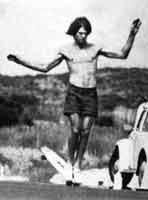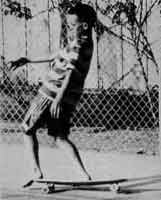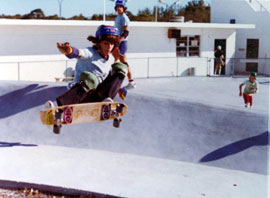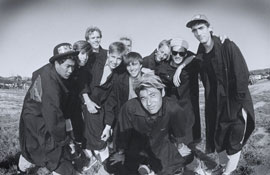 |
 |
 |
    
|
|
|
|
|
|
A Brief history of
Skateboarding In 1963, skateboarding was at a peak of popularity, and companies like Jack's, Hobie and Makaha started holding skateboarding competitions. At this time, skateboarding was mostly either downhill slalom or freestyle. Torger Johnson, Woody Woodward and Danny Berer were some well known skateboarders at this time, but what they did looked almost completely different from what skateboarding looks like today! Their style of skateboarding, called "freestyle", is more like dancing ballet or ice skating with a skateboard.
Then, in 1965, skateboarding's popularity suddenly crashed. Most people assumed that skateboarding was a fad that had died out, like the hoola hoop. Skateboard companies folded, and people who wanted to skate had to make their own skateboards again from scratch.
In the spring of 1975, skateboarding took an evolutionary boost toward the sport that we see today. In Del Mar, California a slalom and freestyle contest was held at the Ocean Festival. That day, the Zephyr team showed the world what skateboarding could be. They rode their boards like no one had in the public eye, low and smooth, and skateboarding was taken from being a hobby to something serious and exciting. The Zephyr team had many members, but the most famous are Tony Alva, Jay Adams and Stacy Peralta.
In 1978, only a few years into the popularity of this new style of low-to-the-ground skateboarding, a skater named Alan Gelfand (nicknamed "Ollie") invented a maneuver that gave skateboarding another revolutionary jump. He would slam his back foot down on the tail of his board and jump, thereby popping himself and the board into the air. The ollie was born, a trick that completely revolutionized skateboarding -- most tricks today are based in performing an ollie. The trick still bears his name, and Alan Gelfand was inducted into the skateboard hall of fame in 2002. Unfortunately, near the end of the 70's skateboarding faced its second crash in popularity. Public skate parks had been being built, but with skateboarding being such a dangerous activity, insurance rates got out of control. This, combined with less and less people coming to use skateparks forced most to close. But skaters kept skating. Through the 80's skateboarders started to built their own ramps at home, and to skate whatever else they could find. Skateboarding began to be more of an underground movement, with skaters continuing to ride, but to make the whole world into their skatepark. During the 80's, smaller skateboard companies owned by skateboarders started cropping up. This enabled each company to be creative and do whatever they wanted - new styles and shapes of boards were tried. It was also during the 80's that the VCR came on the scene, and opened up the world of skateboarding to any kid, anywhere. Stacey Peralta and George Powell pulled together a team of young talented skaters and named them the Bones Brigade. Stacey had a talent for filming, and in 1984 shot the first of a long series of revolutionary skateboard videos - The Bones Brigade Video Show. The team included Steve Caballero, Tony Hawk, Mike McGill, Lance Mountain, Rodney Mullen, Stacy Peralta, and Kevin Staab, among piles of other huge named skaters. Peralta made more Bones Brigade videos - Future Primitive in 1985, and the famous Search for Animal Chin in 1987. There are many, many more. Skateboarding began influencing clothing styles, music and culture. Unfortunately, near the end of the 80's, skateboarding started to dive in popularity again. Vert skateboarding quickly lost popularity, and most skaters only rode street. Each time skateboarding has fallen in popularity, it has fallen a little less. But these dips in popularity have huge impacts on pro skaters. Pure vert skaters like Tony Hawk had a very difficult time holding on through the late 80's and early 90's. The stress on Tony Hawk was incredible, and he even lost his first wife during this time. Vert skateboarding took a dive in fame in the early 90s, but skateboarding still remained, though it became primarily street. It was then that Mike Vallely and Natas Kaupas came on the scene and pushed street skateboarding even further. Skateboarding started to grow again in popularity in the 90's, this time with a more raw, edgy, and dangerous attitude. This coincides with the rise of more angry punk music, and the general discontent with the current system that raged throughout this time frame. Call it discontent, or call it Post Modern frustration, but the image of the poor, angry skater punk came to the surface loud and proud. Interestingly, this only helped to fuel skateboarding's popularity. In 1995, ESPN held their first Extreme Games, in Rhode Island. This first X Games was a huge success, and helped pull skateboarding closer to the mainstream, and closer to being accepted by the general population (read more in the History of the X Games). In 1997 the first Winter X Games were held, and "Extreme Sports" were classified. Plenty of skaters resent the way skateboarding has slowly moved from underground to mainstream. However, the X Games did bring vert skateboarding back into popularity. The X Games and competitions like that have continued to keep vert skateboarding popular, even though vert few skaters actually ride real vert ramps. Vert skateboarding has slowly become a much loved spectator sport. Since 2000, attention in the media and products like skateboarding video games, children's skateboards and commercialization have all pulled skateboarding more and more into the mainstream. The benefit of this is that, of course, skaters are more accepted, and the assumption that all skaters are criminals is slowly being torn down. Also, with more money being put into skateboarding, there are more skateparks, better skateboards, and more skateboarding companies to keep innovating and inventing new things. However, there is a large group of skaters who miss the underground days, and who strongly disagree with the way skateboarding has been made more mainstream. One benefit of skateboarding is that it is a very individual activity. There is no right or wrong way to skate. However, if skateboarding is officially classified as a "sport", many skaters fear that this freedom will die out. There is currently a great deal of concern about skateboarding becoming an Olympic sport (read Skateboarding in the Olympics? for more).
But, with all this
history crammed into such a short period of time, it's easy to see
that no one knows where skateboarding will truly go from here.
Skateboarding still hasn`t stopped evolving, and skaters are coming
up with new tricks all the time. Boards are also continuing to
evolve, as companies try to make them lighter and stronger, or try
to improve on their performance. Skateboarding has always been about
personal discovery and pushing oneself to the limit, but where will
skateboarding go from here? Wherever skaters continue to take it.
References: |
|
Torger Johnson
Woody Woodward
Danny Bearer
Tony Alva
Jay Adams
Stacy Peralta
Alan Ollie Genfald
Bones Brigade
Steve Caballero & Mike McGill
Tony Hawk
Rodney Mullen
|
|
|
|
Designed by Kris 2008 |

 But people still skated, even though parts were hard to find and
boards were home made. Skaters were using clay wheels for their
boards, which was extremely dangerous and hard to control. But then
in 1972, Frank Nasworthy invented urethane skateboard wheels, which
are similar to what most skaters use today. His company was called
Cadillac Wheels, and the invention sparked new interest in
skateboarding among surfers and other young people.
But people still skated, even though parts were hard to find and
boards were home made. Skaters were using clay wheels for their
boards, which was extremely dangerous and hard to control. But then
in 1972, Frank Nasworthy invented urethane skateboard wheels, which
are similar to what most skaters use today. His company was called
Cadillac Wheels, and the invention sparked new interest in
skateboarding among surfers and other young people.









